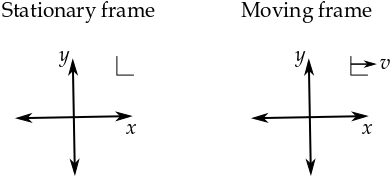You are stationary on the ground, watching as a person walks past you traveling east at
\(\vec{v}_{p,g} = +5 \hat{x} \mathrm{~km/hr}\) toward the front of an airplane which is traveling west at
\(\vec{v}_{a,g} = -150 \hat{x} \mathrm{~km/hr}\text{.}\) The first subscript (
\(p\) and
\(a\)) represents the object, while the second (
\(g\)) indicates that these velocities are given relative to
the ground’s reference frame. Since this also happens to be your reference frame, your velocity is
\(\vec{v}_{y,g} = 0 \mathrm{~km/hr}\text{.}\)
From the walking person’s perspective, you are traveling with velocity
\(\vec{v}_{y,p} = \vec{v}_{y,g} - \vec{v}_{p,g} = -5 \hat{x} \mathrm{~km/hr}\text{,}\) while the airplane is traveling with velocity
\(\vec{v}_{a,p} = \vec{v}_{a,g} - \vec{v}_{p,g} = -155 \hat{x} \mathrm{~km/hr}.\)
See if you can determine your velocity and the walking person’s velocity relative to the airplane!

